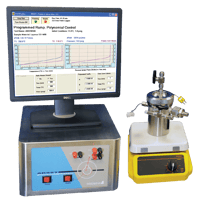10 Tips: Setting Up ARSST Test to Yield Thermal Data and Safe Scale-Up
By Elizabeth Raines, Chemical Engineer, Fauske & Associates
- Prior to each test, perform electrical resistance checks on the temperature and heater glands as well as the thermocouple and heater.
- When installing the foil layer around the heater and heater belt, ensure that the test cell is evenly coated and press firmly around the whole configuration so the foil lies flatly against the cell. This improves heat transfer to the cell evenly.
- Make sure to ground the thermocouple and vessel to the control box and house ground to lower the possibilities of electrical noise.
- Place the ARSSTTM (Advanced Reactive System Screening Tool) vessel square on the center of a stir plate to improve mixing inside the test cell.
- When testing a solid sample, ensure that the test cell is full enough and the thermocouple is low enough so the temperature can still be read when/if the solid melts.
- Keep in mind that the main factors that change calibration polynomials are sample mass, sample heat capacity, and back pressure. If any of these variables vastly changes, it is a good idea to generate a new polynomial.
- As a rule of thumb, when increasing or decreasing the temperature rate of a polynomial, a 0.1 change in the A coefficient results in a heating rate change of approximately 0.3°C/min.
- When installing the thermocouple over the test cell, make sure that there will be no obstruction with the stir bar. If the stir bar repeatedly hits the thermocouple during the test, it could deter mixing or cause noisy temperature readings.
- Remember that the maximum power output for the ARSSTTM is 16.7 W. When the maximum power is achieved during a test, the test is no longer under adiabatic conditions.
- Configuring the test cell setup the same way each test is the key to generating reproducible results. One way of maintaining the test cell configuration is using the same amount of insulation for each test.
Background
Adiabatic calorimeter testing provides data for relief system design, safe scale-up of chemical processes, and changes to process recipes. Safe process design requires knowledge of chemical reaction rates, character and energy release - all of which can be obtained from a low phi-factor adiabatic calorimeter such as the VSP2TM (Vent Sizing Package 2) or ARSSTTM (Advanced Reactive System Screening Tool).
BenefitsThe VSP2TM and the ARSSTTM provide thermal data required for safe scale-up of chemical processes and changes to process recipes. A variety of process upset conditions can be tested to quantify hazards identified by a PHA or HAZOP study. The low phi-factor (or thermal inertia) allows the heat and gas generation rates to be measured and directly applied to the process scale, which leads to appropriately designed emergency relief systems.

Fauske & Associates (FAI) was the principal research contractor for the Design Institute for Emergency Relief Systems (DIERS), an extensive R&D program sponsored by 29 companies under the auspices of AIChE and completed in 1985. Company founder, Hans K. Fauske, D.Sc., served as the principal investigator and overall leader of the DIERS research project. A primary purpose of that effort was evaluation of emergency relief vent requirements, including energy and gas release rates for systems under upset conditions and the effect of two phase flow on the emergency discharge process.
For more information, please contact Elizabeth Raines, eraines@fauske.com or 630-321-4794
#adiabatic test, #process safety, #process hazards


